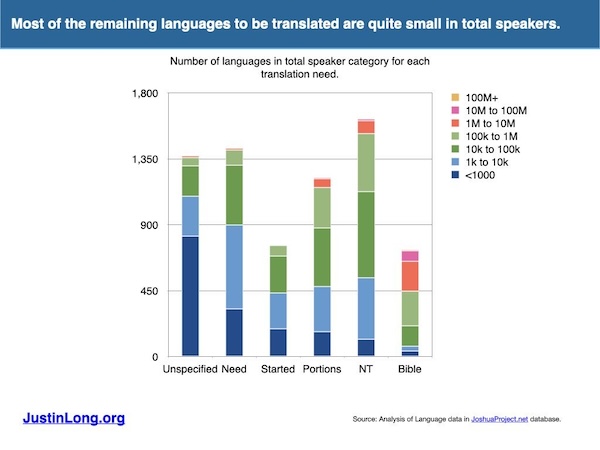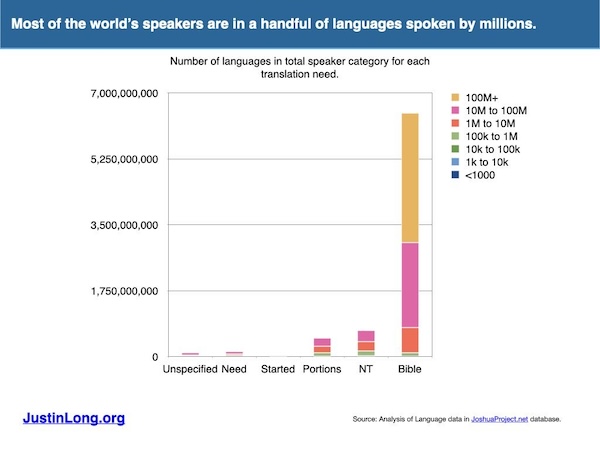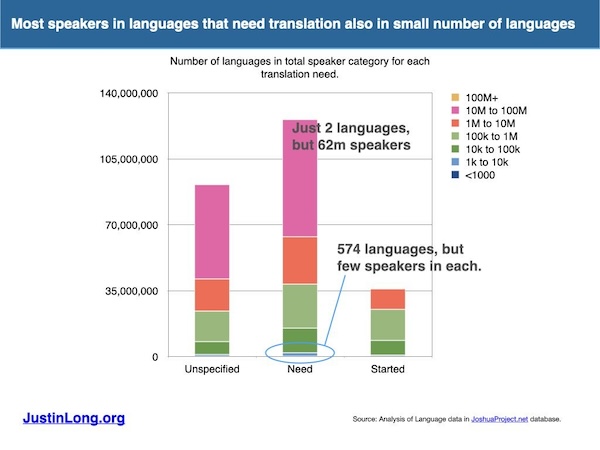% Christian and Scripture Translation
03 Feb 2023There are two long-standing formulas which attempt to describe the situation of people with no access to the gospel: unreached and unevangelized. (Note: the important point is not that people have not yet heard the Gospel—this is true of all babies born this year, for example—but rather that they are unlikely to hear in their lifetime.)
I describe the difference between the two of them in ‘Unreached is not Unevangelized is not Unengaged.’ The basics: unreached is a measure of whether the local church can do the job without cross-cultural assistance. Unevangelized is a measure of access to the Gospel because of certain key ministry types (e.g. Bible translation, literature distribution, broadcasting, the JESUS Film, etc). The history of the term ‘unreached’ and ‘unevangelized’ is well documented in Dave Datema’s excellent paper.
There are two factors in the formulas which are pivotal to the terms: % Christian and the status of Scripture translation. % Christian is a direct component of the % Evangelized scale (if a people group is 60% Christian, it is by definition at least 60% evangelized). Unreached is an ‘on/off’ indicator which is driven by % Christian and % Evangelical. Thus, % Christian is a great ‘rough correlation’ for the unreached/unevangelized status of any given people group: if % Christian is low, it’s unlikely that % evangelized is high (there are a handful of exceptions).
Scripture translation is an important part of the % Evangelized scale. The presence of a translation drives several ministry types. You can’t distribute Bibles that aren’t translated yet. If Luke has been translated, you’re likely to find a JESUS Film team active. And so on.
In order to make progress on reaching the unreached, then, Scriptures need to be translated. What remains of this task? Progress.Bible has a great infographic, albeit slightly out of date (with data from January 2022). I thought to do a 2023 update and take a slightly different tack.
I based this data on Joshua Project’s peoples and language file (the language file being derived from Progress.Bible). First, the global summary of the current status of Bible translation:

There are 7,137 distinct languages in the world (the count in this sheet is off by 1 because a single language ‘unknown’ doesn’t have a translation code). Each row on the table gives data related to languages falling in that particular Scripture Status code: for example, there are 1,426 languages marked as having a ‘Translation Need.’ ‘Speakers’ refers to the population of people groups in Joshua Project marked as having that language—mother tongue speakers. (Data is not readily available for languages spoken as a second language). ‘Christians’ is how many Christians are in those same people groups, using the Joshua Project definition. Non-Christians is simply Speakers minus Christians. The percentage columns should be fairly self-explanatory: thus, in row 5, there are 6.4 billion people in languages that have a Bible translation. Of these, 2.1 billion or 34% are Christians. These 2.1 billion are 89% of all Christians in the world (‘% of all Christians’).
This chart illustrates the immense progress that has been made in translation! This is something to be thankful for: The mother-tongue of 81% of people in our world has a complete Bible. Over 96% of people have at least a portion (which is most likely a Gospel).
However, there are languages and people that still need a translation:


(Slide from forthcoming Global Christianity, 1900-2100 presentation)
Out of 7,137 languages, 2,797 are in status code 0 (unspecified need for translation) or status code 1 (definite need). 2,611 of these are small, with less than 100,000 speakers. Most of the speakers in these 2,797 languages are actually in a handful of the larger languages:


3.4 billion people use one of 10 languages that each have over 100 million speakers: Bengali, Mandarin, English, Hindi, Japanese, Javanese, Portuguese, Russian, Spanish and Urdu. All 10 have full Bible translations available.
269.9 million people speak one of the 2,797 languages that still need a translation. Of these languages, 27 have between 1 and 100 million speakers and need a Bible translation. These 27 have 177 million speakers, or nearly two-thirds of the ‘remaining translation task.’

| Which languages are these 27, specifically? I’ve [set up a query](https://joshuaproject.net/filter?BibleStatus=1 | 0 | 2&min_population=1000000&max_population=100000000&LeastReached=Y) on Joshua Project that will show the unreached people groups who speak a language requiring translation, that have populations between 1 and 100 million people. (Joshua Project lists 24 peoples—there’s an ‘unknown’ language in my list, as well as a few Christian languages that don’t happen to have a Bible translation yet.) If you [widen the query](https://joshuaproject.net/filter?BibleStatus=1 | 0 | 2&min_population=100000&max_population=100000000&LeastReached=Y) to people groups needing translations and having populations between 100,000 and 100 million, you find 165 groups with 112.6 million people. |
While we can be inspired by how far Scripture translation has come, we also see it’s increasingly becoming something akin to a ‘last mile’ problem. It’s fairly easy to string a power line, or a phone line, from a central hub to parts of a city, and from there into individual neighborhoods. The ‘last mile’ problem is the challenge of wiring each individual house from the neighborhood hub. This is often the most complicated and expensive part of the whole process.
We’ve sent thousands of teams to over decades in order to see 3,576 translations (of which 731 are full Bibles). These translations cover most of the people on the planet. But for every heart language to have a Scripture translation, 2,797 languages remain. Sending teams to every language still remaining would nearly require as many people as, for instance, Wycliffe (one of the largest agencies in the world) presently sends!
Might there be other ways? One glaringly obvious method is to look at the peoples that are near to the groups needing translation. Do any of them have large churches or other Christian resources, plus overlap via trade languages? Is it possible Christians from people group 1 could translate the Gospel into people group 2’s language? This is exactly the approach many rapidly multiplying movements are taking: launching local church-based translation strategies, aided by software and informed by global translation experts, to far more rapidly translate the Gospel into these languages.
One way to serve movements is to ask—what can we do to help movements in this process?